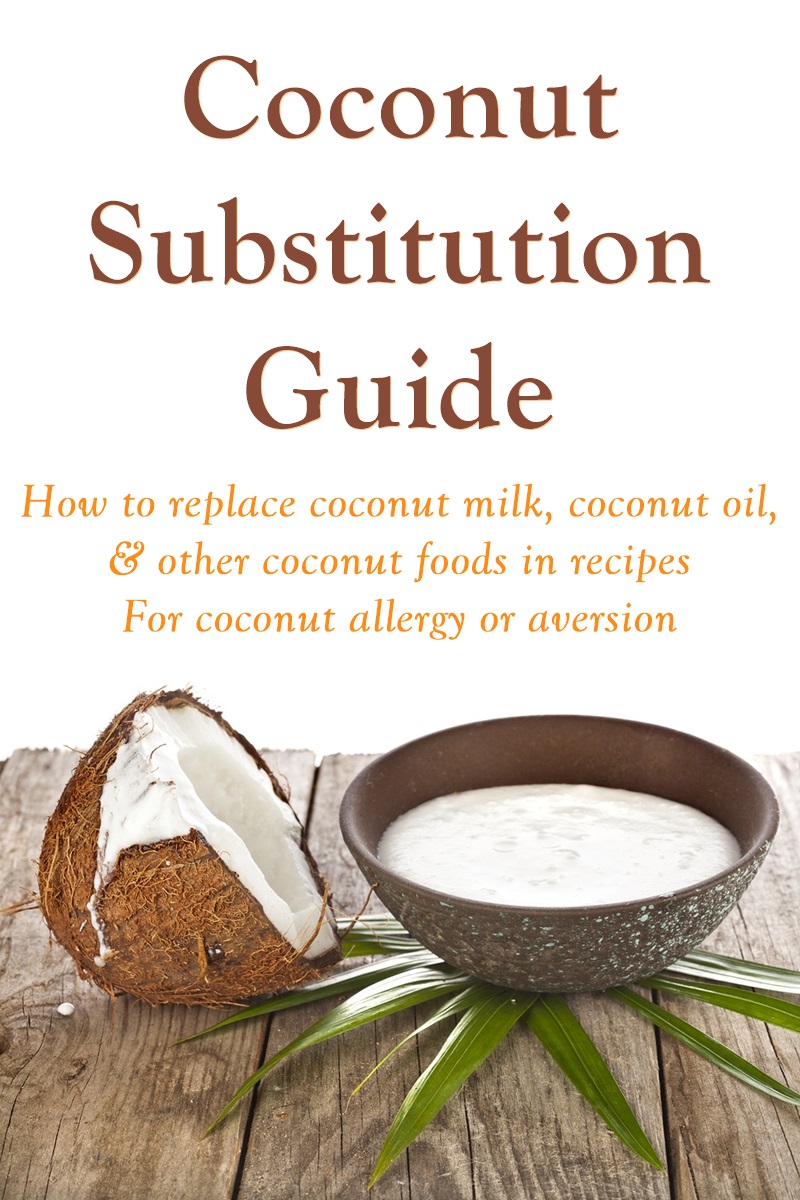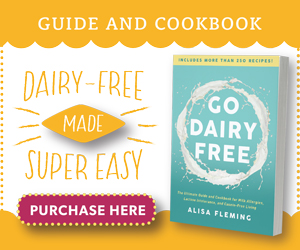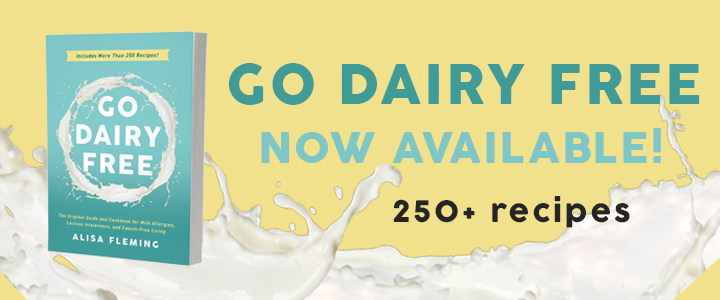Years ago, a reader named Brisa emailed to ask how to substitute for coconut in recipes.
I was wondering, what would be a good substitute for coconut milk and coconut oil? I don’t like the taste of coconut and I would prefer to buy things that my whole family could use.
Coconut, which is technically a fruit or drupe (not a tree nut), has so much to offer dairy-free consumers. But not everyone likes the flavor that it imparts. Also, coconut allergies are a reality for some people. The following includes some of my personal tips from Go Dairy Free: The Guide and Cookbook to help you substitute for coconut milk and oil in recipes, while keeping them dairy-free.

How to Substitute for Canned Coconut Milk
This is the “authentic” stuff that comes in the cans and is available in light or regular / full fat. You can read more about it in my Coconut Milk Primer. We like this ingredient for its natural, rich profile that mimics dairy cream in consistency. Though a substitute is never “the real thing,” here are some options that should work in your recipes:

Nut Cream – This is my personal preference and a great option for those who aren’t allergic to tree nuts. You can make nut cream from any soft nut, but I like cashews the best. They have the most neutral flavor, but with a slight sweetness. See the Essential Dairy Subs chapter in Go Dairy Free: The Guide and Cookbook for my homemade Nut Cream recipe, or use this simple Heavy Cashew Cream Recipe that we have posted online.
Silken Tofu – Pureed silken tofu is a fair stand-in for coconut milk in recipes, and one that low fat dieters sway toward. Brands that come in aseptic packages, such as Mori-nu, seem to yield good results. Just be sure to pick an organic or non-GMO variety. One 12-ounce package of silken tofu makes about 1 1/2 cups of tofu puree. A can of coconut milk is about 1 2/3 cups. You can pour the pureed silken tofu into a glass measuring cup and add enough to reach 1 2/3 cups if you need a full can.
Fat + Liquid – If the coconut milk is used in a baked good, you can replace it with a combination of oil or dairy-free margarine and additional liquid. The liquid could be a low fat milk alternative, juice, or water. Whatever you feel goes best with your recipe. Here are some ratios to go by:
- 1 cup coconut milk = 1/4 cup oil + 3/4 cup liquid
- 1 cup coconut milk = 1/3 cup melted dairy-free margarine + 2/3 cup liquid
Dairy-Free Creamer – If the recipe calls for light coconut milk, you can lean on soy, almond, or pea protein creamer for a fair coconut-free substitute.
No Coconut Allergy? There’s no denying the pronounced flavor of good quality coconut milk. But I think it melds seamlessly into recipes that call for complimentary ingredients like curry, mint, pumpkin, or sweet potatoes. In fact, no one ever guesses that my popular pumpkin pie recipe is made with coconut. And you can partially mask coconut flavor with ingredients like vanilla extract. In sweet recipes where I don’t want a pronounced coconut flavor, I often add 1/2 to 1 1/2 teaspoons of vanilla extract per cup of coconut milk.
How to Substitute for Coconut Cream
Coconut cream is the very thick cream that forms when coconut milk separates. You can learn more about it in my and my Visual Guide to Coconut Milk & Cream. It’s used in recipes to replace heavy cream and can be whipped to substitute whipped cream.
Nut Cream – A thicker nut cream works well in place of coconut cream in many recipes. See the Essential Dairy Subs chapter in Go Dairy Free: The Guide and Cookbook for my homemade Nut Cream recipe. It doesn’t whip like coconut cream, but it still adds a creamy finish to desserts, sauces, and more.
Silken Tofu – Extra-firm silken tofu purees easily and is a nice, thick 1:1 substitute for coconut cream. It’s also a great option if you prefer a lower fat alternative. One 12-ounce package of silken tofu makes about 1 1/2 cups of tofu puree. A can of coconut cream is about 1 2/3 cups. You can pour the pureed silken tofu into a glass measuring cup and add enough to reach 1 2/3 cups if you need a full can.
Store Bought Cream Alternatives – Most brands of dairy-free “cream” or “whipped cream” are made with coconut. But there are a few coconut-free products on the market. See my Guide to Dairy-Free Whipped Cream to learn more about the options.
No Coconut Allergy? Like coconut milk, coconut cream can “disappear” into recipes with bold flavors, like chocolate. But if it’s the star of the show, I would stick with one of the substitute options above.
How to Substitute for Coconut Milk Beverage
It’s easy to confuse coconut milk beverage with canned coconut milk, since those cartons are becoming quite popular. Make sure to clarify which type is being used in a recipe. If it is coconut milk “beverage” (the stuff sold in cartons under brands like So Delicious and Silk), then you can substitute your favorite dairy-free milk alternative in an equivalent amount.
I like cashew milk the best, as it is richer, like coconut milk beverage, and has a versatile flavor. However, you can substitute for coconut milk beverage with soymilk, almond milk, rice milk, or just about any other milk alternative. There are so many!
But different dairy-free milk beverages can produce slightly different results in some recipes, and the flavor profile should always be taken into consideration. For example, some people like the taste of almond milk beverage in mashed potatoes, while others loathe it. And sauces might thicken differently depending on the fat content and additives in the milk beverage.
No Coconut Allergy? If you use dairy-free milk beverage regularly on cereal and in smoothies, then there isn’t much point in keeping coconut milk beverage on hand if you don’t like it. But if you mostly use it in recipes, don’t run from coconut milk beverage without trying it. It’s mild enough that you won’t taste “coconut” in most soups, sauces, and baked goods. And it has a natural richness that performs well in many recipes.
How to Substitute for Coconut Oil
Coconut oil is one of the few plant-based fats that has a high ratio of saturated fat, like dairy. This makes it solid at cooler room temperatures, offering more versatility and a somewhat buttery texture. Nonetheless, it isn’t required for baking or cooking.
If a solid fat is needed in your recipe, then you can turn to organic palm shortening (look for RSPO certified for sustainable options). Palm shortening has a more neutral flavor, and is always solid at room temperature, but it has similar properties to coconut oil. Another alternative is dairy-free buttery spreads or sticks (formerly known as non-hydrogenated margarine!). Buttery spreads and sticks have a little more flavor than coconut oil, but this may not be a bad thing. Food-grade cocoa butter can also work well as a substitute in some recipes that call for coconut oil’s firming power, including no-bake treats.
If your recipe calls for melted coconut oil, you can substitute it with your favorite baking or cooking oil. I lean toward grapeseed oil and olive oil, but you might like canola or vegetable. They will all work comparably as a substitute for coconut oil in recipes. Just keep the overall flavor profile of the dish or baked good in mind. I include additional information on how to use oils in baking and oil smoke points for cooking in Go Dairy Free: The Guide and Cookbook.
No Coconut Allergy? If you aren’t allergic to coconut, but you just hate the taste, then you can look for a refined coconut oil. The coconut flavor and scent is removed in the refining process, and it performs exactly the same in recipes as unrefined coconut oil.
How to Substitute for Coconut Butter
Coconut butter is essentially pureed coconut meat. It retains all of the fats, solids, and flavor of coconut. I don’t reach for coconut butter often, but you might see it in some “healthier” recipes.
In no bake bites, bars, and energy balls, you can usually substitute your favorite nut or seed butter for coconut butter. You might need a little extra moisture since coconut butter is fattier than nut butters.
In baked goods like cookies, dairy-free buttery sticks often work in place of coconut butter. In muffins or quick breads, any type of baking oil or buttery spread can usually work. Or you might opt to substitute part nut or seed butter (about 1/3) and part oil (about 2/3).
No Coconut Allergy? Coconut butter does have a very pronounced flavor. So if you are averse to the taste of coconut, I would go with one of the substitution options above.
How to Substitute for Shredded Coconut
These days you can easily find coconut flakes, unsweetened coconut shreds, and sweetened coconut shreds in stores. They are typically used to provide coconut flavor and texture to recipes.
In most recipes, you can simply omit the coconut or swap in another flavorful add-in like chocolate chips, seeds, sliced almonds, other chopped nuts, or dried fruit. However, flaked or shredded coconut does release some oils as it cooks or bakes. And sweetened shredded coconut supplies even more moisture. So your end result might be just a touch drier without the coconut. If so, you can add just a wee bit more oil or sweetener in your next batch.
Some people like to substitute rolled or quick oats for coconut. This can be a good idea from a taste and texture perspective. But keep in mind that coconut releases oil while oats absorb moisture. The latter will produce a drier finished good.
No Coconut Allergy? Shredded and flaked coconut is the real stuff. If you are averse to the flavor of coconut, I just recommend omitting or replacing the coconut as mentioned above.
How to Substitute for Coconut Sugar
In an effort to make sweets healthier, a lot of recipe creators use coconut sugar. It is lower on the glycemic index than regular cane sugar, but it’s also a little less sweet. And some people might not like the more subdued coconut-caramel like flavor.
The easiest substitute for coconut sugar is sucanat, which is essentially unrefined cane sugar. It can be swapped in a 1:1 ratio. For a more intense flavor, you can substitute lightly-packed brown sugar. If you firmly pack the brown sugar, expect a sweeter result.
No Coconut Allergy? Coconut sugar does have it’s own unique flavor, but it isn’t as “coconut” in taste as many other coconut foods. Even if you are averse to the taste of coconut, you might like it.


47 Comments
This was so helpful. I needed to replace full fat coconut milk in a cake recipe and your advice worked perfectly!
Thank you so much!
So glad I could help!
I purchased an air fryer with some recipes that call for coconut milk, i have a jar of coconut oil, can it be converted somehow? I do not know if i have coconut allergies or not.
Coconut oil is extracted from coconut milk. You might be able to create an oil water emulsion, but I’m not sure it would work the same.
Thank you for this post!! I was diagnosed with dairy and coconut allergies at the same time. I discovered on my elimination diet that coconut is often used to substitute for dairy! Both make me feel equally ill so I’m excited to try some of these substitutes on recipes I’d written off because of the coconut!
So happy I can help you Lizzy!
Thank you so much! I am new to vegan eating but doing well except I can’t tolerate coconut products, you have awesome info, my confusion is gone.
Glad I can help!
You state that regular oil can be substituted for coconut oil. However, my cake recipe is flourless and is made with cooked quinoa. As a non-professional, I do not know whether it is used as a binder (in which case I think melted cocao butter would be a good substitute) or just as part of a regular cake recipe. What is your suggestion? Of course, I’d rather use grapeseed oil as I would ordinarily do with a flour recipe.
Hi Janet, does your recipe call for chilling? If you refrigerate the cake, then yes, coconut oil (or one of the saturated subs noted above) will be best for helping it firm up in the refrigerator. If it is left at room temperature, then the recipe creator should have already taken into account that coconut oil stays liquid at many room temperatures. Coconut oil doesn’t have any binding power, per say, but rather it solidifies as it cools, helping things “set up” when chilled. If not chilled, then any oil can be used. I’ve used grapeseed oil in my flourless brownies recipe many times! -> https://www.godairyfree.org/news/chocolate-fudge-gluten-free-brownies
Ok so i gonna try and ask this question properly. I have a coconut sensitivity and my husband is allergic to cashews. I am also lactose intolerant and not doing dairy and slowly getting off of gluten. What can i use as a dairy subsitute that does not consist of coconut or cashews. Oh! i forgot, since i am trying to heal my gut i also don’t touch soy since i find it hard on my digestive issues. I hope you can help.
Hi Natalie, see my fat+liquid and creamer sub options above. The former is free of all of these things, and for the latter, there are a couple of options available that are free of these, too.
Hi,
I am looking for some vegan cheese recipes for pizza, crackers, nachos, grilled cheese, etc.; hard, melted and sliced. One of my children has tree-nut allergies and the other one has coconut allergies.
Can you recommend some recipes for me without the nuts and the coconut ingredients?
Thank you.